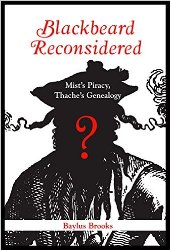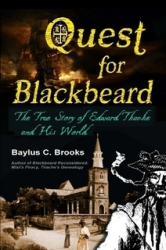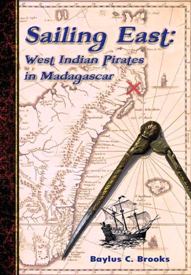 Pirates and Privateers Pirates and Privateers
The History of Maritime
Piracy
Cindy Vallar, Editor
& Reviewer
P.O. Box 425,
Keller, TX 76244-0425
    
Books for Adults ~ Biography:
Pirates, Privateers, & Pirate Hunters
History: Piracy
Blackbeard Reconsidered
Dictionary
of Pyrate Biography
Quest for
Blackbeard
Sailing East

Blackbeard Reconsidered: Mist’s Piracy, Thache’s
Genealogy
By Baylus C. Brooks
North Carolina Office of Archives and History, 2015,
ISBN 978-0-86526-479-3, US $10.00
e-book ISBN 978-0-86526-483-0, US $7.99
    
One of the most
influential books on pirates of the golden
age is Captain Charles Johnson’s A
General History of the Robberies and
Murders of the Most Notorious Pyrates
(1724). Historians often refer to it; it
has inspired well-known novelists; and its
author’s identity has been debated for
centuries. Not bad for a book that has
been in print for nearly 300 years. But
how reliable is it as a primary source?
The author does embellish some elements
about the pirates, but other details can
be substantiated as fact. What Brooks
examines in this forty-three-page book is
the accuracy of the portrayal of Edward
Thache, more commonly known as Blackbeard.
Brooks agrees with historian Arne
Bialuschewski’s assessment that Johnson’s
true identity belongs to Nathaniel Mist.
This printer/ publisher vilified
Blackbeard, even though historical
documents provide evidence that other
pirates, such as Ned Low, were far more
brutal. In fact, victims’ eyewitness
testimony never once gives evidence that
Thache slays anyone before he faces
Lieutenant Robert Maynard in November
1718. In examining Mist’s account of
Blackbeard, Brooks states that Mist chose
to ignore primary sources in crafting his
depiction of Thache’s life as a pirate –
not once, but differently for each edition
of the book.
The author also scrutinizes the
historiography of Blackbeard and early
18th-century piracy, showing how Mist’s
portrayal impacts later studies of this
pirate. These publications include Hugh F.
Rankin’s The Pirates of Colonial North
Carolina (1960); Harold T. Wilkins’s
“On the Treasure Trail of the Wicked Old
Pirates” (American Weekly, 11
February 1940); Marcus Rediker’s Between
the Devil and the Deep Blue Sea
(2007); Robert E. Lee’s Blackbeard: A
Reappraisal of His Life and Times
(1974); Patrick Pringle’s Jolly Roger:
The Story of the Great Age of Piracy
(1953); Angus Konstam’s Blackbeard:
America’s Most Notorious Pirate
(2006); and Kevin Duffus’s The Last
Days of Black Beard the Pirate
(2008).
One of Brooks’s assertions is that these
histories have further muddied the water
about Blackbeard. This pirate’s surname
also complicates the issue. Is it Teach,
Thatch, Thache, Drummond, or Beard? And
what of his life before he becomes a
pirate? According to Brooks, historians
tend to rely on primary source material
without always searching genealogical
sources. Since Blackbeard is believed to
come from Bristol, some have checked
British records there without turning up
any evidence to support this claim. What
if Thache comes from nearby Gloucester, or
even Jamaica? Brooks discusses
genealogical records in both places to
locate several Thaches, including the
family of Edward Thache, which the author
then shares with readers.
Originally published as an article in The
North Carolina Historical Review,
this book includes footnotes,
illustrations, and an index that clearly
demonstrate the depth of Brooks’s
research. He makes a compelling and
persuasive argument about Johnson’s real
identity, the reasons for vilifying
Blackbeard, and whether the Thaches of
Jamaica may be related to the pirate
Edward Thache. This book serves to whet
the reader’s appetite for his in-depth
study, Quest for Blackbeard: The True
Story of Edward Thache and His World,
which is slated for publication in 2016.
Review Copyright ©2016 Cindy Vallar


Dictionary of Pyrate Biography
1713-1720
By Baylus C. Brooks
Poseidon, 2020, ISBN 978-1-67818-234-2, US
$49.95
    
Over
the years, a number of biographical
dictionaries have been published
that focus on pirates, or pirates
and subjects of peripheral interest.
The primary time period of these
books focuses on the 17th and 18th
centuries. This volume further
narrows this span to the most
prolific period of pirate history,
known as the golden age of piracy.
What sets Dictionary of Pyrate
Biography apart from all other
similar volumes is its content,
making it both unique and vital to
anyone seeking quality information
on these sea marauders.
Perhaps, Brooks says
it best: “This book is an attempt
to retell the stories of each
pirate, but only from the actual
primary source records available.”
(2) As he explains, one go-to
resource that researchers often
consult and quote is the 1724
edition of Captain Johnson’s A
General History of the Robberies
and Murders of the Most
Notorious Pyrates. Relying
on this book isn’t the best
documentary evidence because the
true identity of the author is
unknown; the chapters are a blend
of fact and fiction; and it’s a
secondary resource that fails to
identify where the author secured
his information. To provide
historians, researchers, and
pirate aficionados with a resource
that is more accurate and provides
citations for the quoted
documents, Brooks compiled this
collection. He begins with the
list of 209 pirates who take
advantage of the king’s pardon in
1718 and surrender to Captain
Vincent Pearse. From there, Brooks
expands the contents through his
own research and with the help of
other experts.
A number of entries
consist only of the fact that they
give themselves up to Pearse. Many
entries provide additional details
about individual pirates. What
these are not are cohesive,
seamlessly interwoven narratives
of each pirate. Instead, they
begin with a brief paragraph that
includes known biographical
details – such as birthplace and
date, piratical career, and, if
captured, what became of the
person – after which are
quotations from contemporary
documents pertaining to the
individual. Where feasible, these
are quoted in full. It is up to
the reader to sift through and
decipher the provided information,
and then do further research to
fill in the gaps. The length of
each entry depends on the person
and what is known about him or
her. It can be as short as a
single sentence or extend from a
few paragraphs to several pages.
While the majority of
individuals in this dictionary,
which is arranged alphabetically
by last name, are pirates, readers
will also find entries on pirate
hunters, naval personnel, victims,
merchants, captives, and
governors. Most are men, but there
are a few women. The inclusion of
a handful of personages is
unclear, since their connections
to pirates are murky at best.
(Examples of these are Colonel
Daniel Axtell, who is connected
with regicide, and Dr. William
Axtell, who petitions to rebuild
Port Royal after it is destroyed
twice.) Many names will be
unfamiliar to readers, but others
are quite well-known: Stede
Bonnet, Anne Bonny, Colonel
William Rhett, Governor Alexander
Spotswood, Captain William
Snelgrave, and Edward Thache to
name a few. (One name that is
absent is Governor Woodes Rogers,
but Brooks assures me that this
oversight will be corrected in the
second edition.)
There are a few
drawbacks to accessing the
valuable information contained in
this book. Variant spellings are
only listed with the main entry
for the pirate. For example, the
user has to know that
documentation for Blackbeard will
only be found under Edward Thache.
There are no see references to
this entry if you look under
Blackbeard, Theach, Teach, or
Thatch. Although the appendix
contains a list of those pirates
who surrender to Captain Pearse,
there is no master index or table
of contents and no list of pirates
who serve under specific captains.
For example, if you’re looking for
all the pirates connected to Stede
Bonnet, you need to know their
names ahead of time or page
through the entire book in hopes
of finding them.
Testimonies are
included with some entries. These
are invaluable, but they aren’t
easy to read because of the ink
color chosen to differentiate
between Query and Response. The
questions are in black, but the
answers are in light gray, which
is difficult to see, let alone
read.
On the other hand,
there are advantages to this book
beyond the primary documents.
Brooks includes maps, photographs
of actual sources, pictures, and
family trees throughout the book.
Among these are examples of Round
Robins, a way of signing a paper
without any one name being higher
than another. Everything is
footnoted on each page, so readers
readily know where the material
comes from. Another notable
feature is the inclusion of a few
“unknown pirate” entries; their
deeds are known, but their names
have been lost to history.
“Treasure” is a word
intricately associated with
piracy, and this volume is indeed
a treasure as invaluable as any
the sea marauders acquired during
the golden age. It provides at
one’s fingertips a wealth of
knowledge that will save countless
precious hours of research, which
may, in turn, unearth even more
material that will be included in
future editions of this work. The
Dictionary of Pyrate Biography
belongs in every collection where
the truth about pirates and their
deeds is highly sought and prized.

Quest for
Blackbeard: The True Story of
Edward Thache and His World
By Baylus C. Brooks
Lulu, 2016, ISBN
978-1-365-32821-3, paperback
$39.00
ISBN 978-1-365-25885-5, hardback
$59.96
    
Who was Blackbeard?
The answer to this is
far from simple,
because many legends
surround this elusive
person. In Quest
for Blackbeard,
Brooks sifts through
genealogical and
historical records to
provide a fact-based
response to this
question. His use of
these primary
documents, some of
which haven’t been
seen before, allows
him to distill facts
from fiction. He does
refer to secondary
sources, but only to
highlight how these
narratives diverge
from or defend his
findings.
Since
1724 and written six
years after
Blackbeard’s death,
a main source on
pirates, including
Blackbeard, has been
Captain Charles
Johnson’s A
General History of
the Robberies and
Murders of the
Most Notorious
Pyrates. Its
author was a
contemporary,
familiar with the
political and social
constraints of the
early 18th century.
His true identity
remains unknown,
although Daniel
Defoe and Nathaniel
Mist are two
candidates for this
person. Brooks sides
with historian Arne
Bialuschewski, who
makes a good case
for the latter being
Johnson, and this
becomes evident as
readers delve into
the pages of Quest
for Blackbeard.
Over time,
historians have come
to recognize that
Johnson blurs true
history with
fiction, so A
General History
is more
semi-biographical in
nature. This is why
Brooks seeks
information from
more reliable
resources to uncover
the truth about
Edward Teach, alias
Blackbeard the
pirate.
While
Blackbeard’s
piratical career is
known, his origins
are mired in
mystery. Brooks,
with assistance from
other researchers
and genealogists,
has uncovered
documentary evidence
in Jamaica that
sheds light on this
quandary.
Blackbeard’s real
name was Edward
Thache, although
through the years it
has been spelled
Teach, Thatch,
Theach, and Tach – a
byproduct of an era
when spelling wasn’t
uniform. He was
probably born in the
environs of Bristol,
England, and
immigrated to
Jamaica as a young
lad with his parents
and sister. His
family had wealth
and social standing
in the island’s
capital of Spanish
Town (St. Jago de la
Vega). During Queen
Anne’s War (known as
the War of the
Spanish Succession
in Europe), he
served aboard HMS Windsor.
While no ship’s logs
or muster books
support this – and
Brooks provides good
reasons why this
might be – a
Jamaican deed
provides this
information.
History
has often been
taught in a vacuum,
so our understanding
of events doesn’t
always include the
whole picture. In
order to truly
understand Thache,
it’s important to
view him from the
perspective of the
world in which he
lives and through
the eyes of those
who either know him
or are impacted by
him. Brooks ably
provides this
historical context,
sometimes diverting
from the straight
and narrow, but he
always brings the
focus back to
Thache. For this
reason, readers
simply seeking a
book just about
Blackbeard won’t
find it within these
pages. Instead, we
are treated to a
treasure trove of
information that
gives a better
understanding of
Thache’s world,
piracy in general,
and how politics,
the media, and
changing attitudes
influence how he was
and is viewed.
Brooks
touches on a wide
variety of
interconnected
topics that may have
influenced
Blackbeard in
varying degrees.
These include
Jacobites, class,
and religion, as
well as locations
such as Jamaica, the
Bahamas, and the
Carolinas. Among the
many pirates
discussed are
Elizabethan Sea
Dogs, Benjamin
Hornigold, Henry
Avery, Robert
Searle, Charles
Vane, Henry
Jennings, Samuel
Bellamy, and Stede
Bonnet. Brooks also
spotlights men who
either supported or
worked against
pirates, such as Sir
Thomas Modyford,
Nicholas Trott,
Charles Eden, Tobias
Knight, William
Rhett, and Alexander
Spotswood. By
examining all these
people within the
proper historical
context, Brooks
suggests we need to
revisit and revise
our “general modern
view of dirty, poor,
and destitute
pirates, at least
their leaders.” (9)
Throughout
the 651 pages of
this book Brooks
shares what other
historians and
authors have written
about Blackbeard.
Among these are
Peter Earle, Colin
Woodard, Marcus
Rediker, Mark Hanna,
Robert E. Lee, and
David Cordingly –
names many readers
familiar with pirate
histories readily
recognize. While
Brooks agrees with
some, he disagrees
with others.
Authors’ personal
biases and agendas
influence their
writing, and readers
should understand
these when reading
non-fiction. Brooks
certainly recognizes
this and, for the
most part, his
presentation is
equally weighted;
however, his
discussions on
armchair historians
(those with no
formal training in
historical research)
and those who
“adopted” Thache as
a North Carolinian
demonstrate his own
biases because the
arguments come
across more as rants
than impartial
evaluations.
While
revising our
understanding of
pirates is one of
Brooks’s goals in
writing Quest
for Blackbeard,
he states two
others. One pertains
to corrupt private
colonies and the
need for “central
government control
for any progress to
commence once . . .
Britain dominated in
America.” (9) The
second pinpoints an
epicenter for the
dawning of the
golden age of
piracy: the July
1715 hurricane that
resulted in the
catastrophic wreck
of eleven of Spain’s
treasure ships. The
information he puts
forth in this
narrative
masterfully supports
these goals.
Each of
the fifteen chapters
begins with a
quotation and has
numerous
subheadings.
Footnotes are
provided on pages
where the source is
referred to, but
there is no
bibliography. This
requires readers,
who are interested
in locating the
resource, to find
its original
footnote for the
full citation.
Figures
(illustrations,
maps, family trees,
timelines, and
charts) are
renumbered with each
chapter and no
master list with
page numbers is
provided for easy
reference. Nor are
they always referred
to within the
narrative. There are
three appendices,
although the
references to them
within the narrative
aren’t uniformly
indicated. (The
print in Appendix C
is small and may
require a magnifying
glass to read.) The
extensive index,
however, mitigates
these oversights to
some degree.
Quest
for Blackbeard
is an absorbing
account of Brooks’s
quest to learn the
history behind the
legend. He admits
that genealogy
involves assumptions
and identifies where
he speculates on
some aspects of
Thache’s life and
his contemporaries.
This is why readers
will encounter words
such as "likely,"
"probably," and
"possibly"
throughout their
reading. These
suppositions don’t
detract from the
importance of his
research. The book
is an invaluable
addition to any
pirate collection,
and the “new”
historical evidence
and
thought-provoking
conclusions provide
stimulating areas
for future research
and conversation.

Sailing
East: West
Indian Pirates
in Madagascar
By Baylus C.
Brooks
Poseidon
Historical
Publications,
2018, ISBN
978-0359047925,
US $29.95
Also available
in other formats
    
One
of the most quoted resources on pirate history
is a book published in 1724, written by an
unknown author who called himself Captain
Charles Johnson. The problem with A General
History of the Robberies and Murders of the
Most Notorious Pyrates is that it is
actually a blend of fact and fiction. Brooks
makes it a point “to forget this flagrantly
fickle source and focus entirely on only primary
documents.” (Acknowledgements) This time around,
he turns his attention to Western pirates who
ventured into the Indian Ocean to plunder the
riches of Mughal India and become a thorn in the
English East India Company’s side.
When Henry Every captures the
Gang-i-Sawai in 1695, he demonstrates
to his fellow pirates just how rich the
takings are in Eastern waters. Economically,
India is the most important country in the
world. The Mughal emperor uses his clout to
demand recompense for Every’s attack. Since
Every has returned to the Caribbean, that’s
where he is sought and, slowly, England and
her colonies attempt to make the West Indies
an undesirable hunting ground for pirates,
especially after Woodes Rogers arrives in the
Bahamas to bring an end to the pirate republic
at New Providence.
So the pirates turn their
attention to the East. This is where Brooks
begins “the tale of the last West Indian
pirates who, cornered by social progress,
drawn by legend, and such gilded fantasies of
the last generation of buccaneers, sailed east
for Madagascar.” (23) This examination begins
and ends with Olivier LeVasseur, better known
as la Buse or the Buzzard. The intervening
chapters discuss the capture of the British
East India Company’s Cassandra,
captained by James Macrae; plundering the
Indian ports of Bombay, Goa, and Cochin;
Edward Congdon; the capture of the Nossa
Senhora do Cabo and her passenger, the
Viceroy of Goa; an anti-piracy squadron; and
Richard Taylor, a pirate who eventually seeks
a pardon and employment from the Spanish.
The hallmark of Brooks’s
investigations is that he relies only on
primary documents to tell the pirates’
stories, and he vets these sources to
determine their reliability, a process he
shares as the tales unfold. Readers meet many
pirates – including Thomas Cocklyn, Howell
Davis, Jasper Seager, and Edward England – but
this is far more than just a pirate history.
Interwoven throughout the narrative are
discussions on connected topics, such as
captives Captain William Snelgrave and Richard
Lasinby, Jacobitism and Stuart Anti-government
Conservatism, Johnson’s Edward England versus
the real Edward England, and Edward Congdon
versus Christopher Condent. Interspersed
throughout the book are maps, illustrations
from documents, and pictures. Footnotes are
included instead of endnotes, as are a
spreadsheet showing the ships seized by
LeVasseur, Cocklyn, and Davis while Snelgrave
was a prisoner, and See references identifying
where topics are covered in greater detail.
Aside from a twenty-two-page index, there are
also seven appendices. These are: A list of
ships allegedly taken by pirates on the
African Coast in spring-summer 1719; The London
Journal, 17 February 1722; Snelgrave
Letter – 30 April 1719; Snelgrave Letter – 1
August 1719; Snelgrave Deposition – 20 January
1721; Three Lasinby Narratives – March 1722;
and Detail of HMS Phoenix Log Entries
22 February – 24 April 1718.
Sailing East is an
invaluable and illuminating tool for people
seeking primary documentation on pirate
history. Its focus on western pirates in the
waters around Africa and the Indian Ocean is a
refreshing departure from the normal fare of
Caribbean piracy.

Click to contact me
Background image compliments
of Anke's Graphics |




